Financial Analysis of Petrochina: A Detailed Report
VerifiedAdded on 2021/04/16
|19
|4459
|22
Report
AI Summary
This report provides a comprehensive financial analysis of Petrochina, evaluating its performance over two years. It examines profitability, liquidity, and solvency ratios, revealing a decline in profitability and challenges in liquidity due to falling market demand and increasing obligations. The analysis highlights Petrochina's strong solvency position, achieved through equity financing. The report also discusses the importance of independent audits, referencing Price Water House Coopers' audit of Petrochina. Furthermore, it explores the impact of the 2007/08 financial crisis on the company and draws lessons for international organizations. The report concludes that while Petrochina faces profitability and liquidity challenges, its solvency remains stable due to its financial strategies.
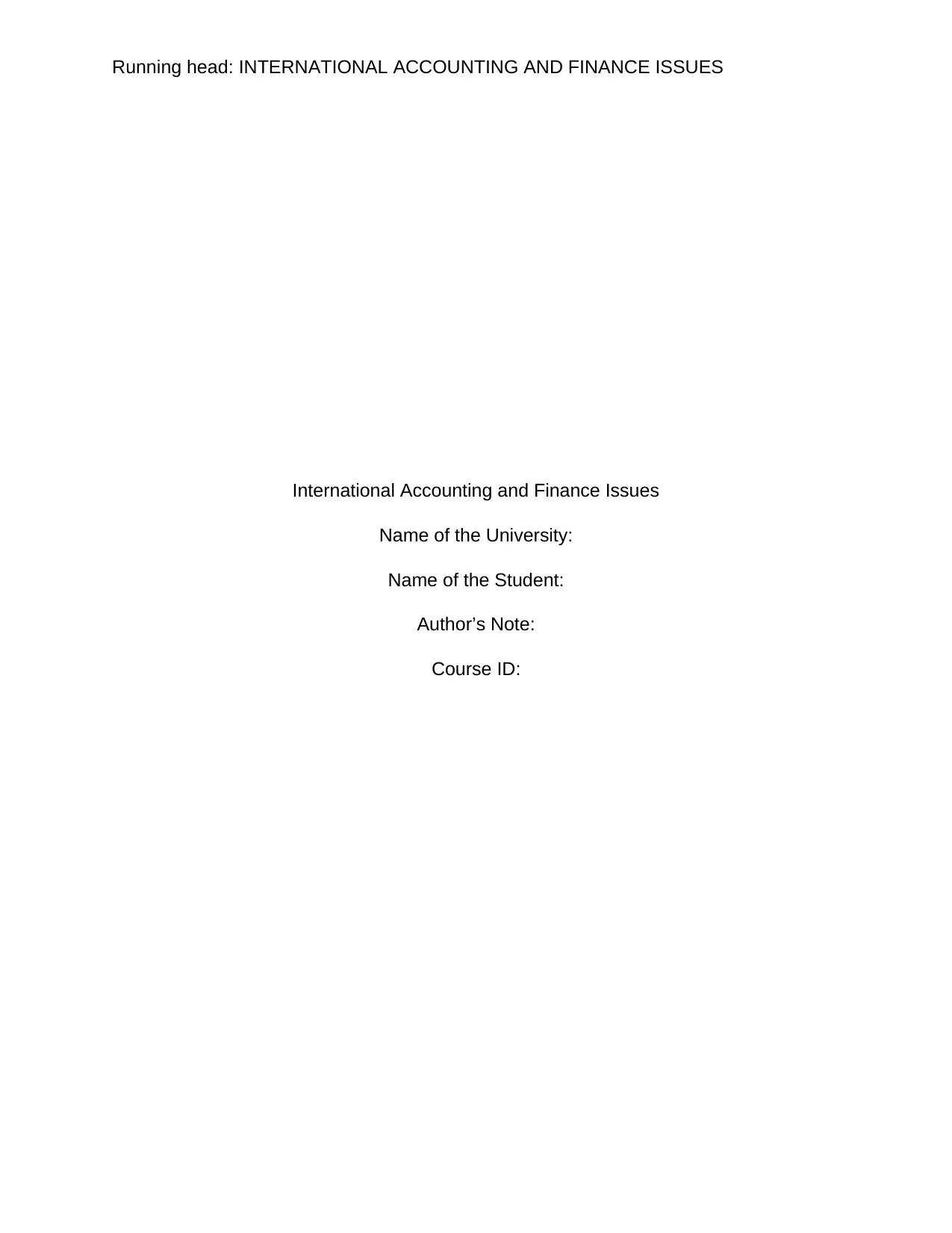
Running head: INTERNATIONAL ACCOUNTING AND FINANCE ISSUES
International Accounting and Finance Issues
Name of the University:
Name of the Student:
Author’s Note:
Course ID:
International Accounting and Finance Issues
Name of the University:
Name of the Student:
Author’s Note:
Course ID:
Paraphrase This Document
Need a fresh take? Get an instant paraphrase of this document with our AI Paraphraser
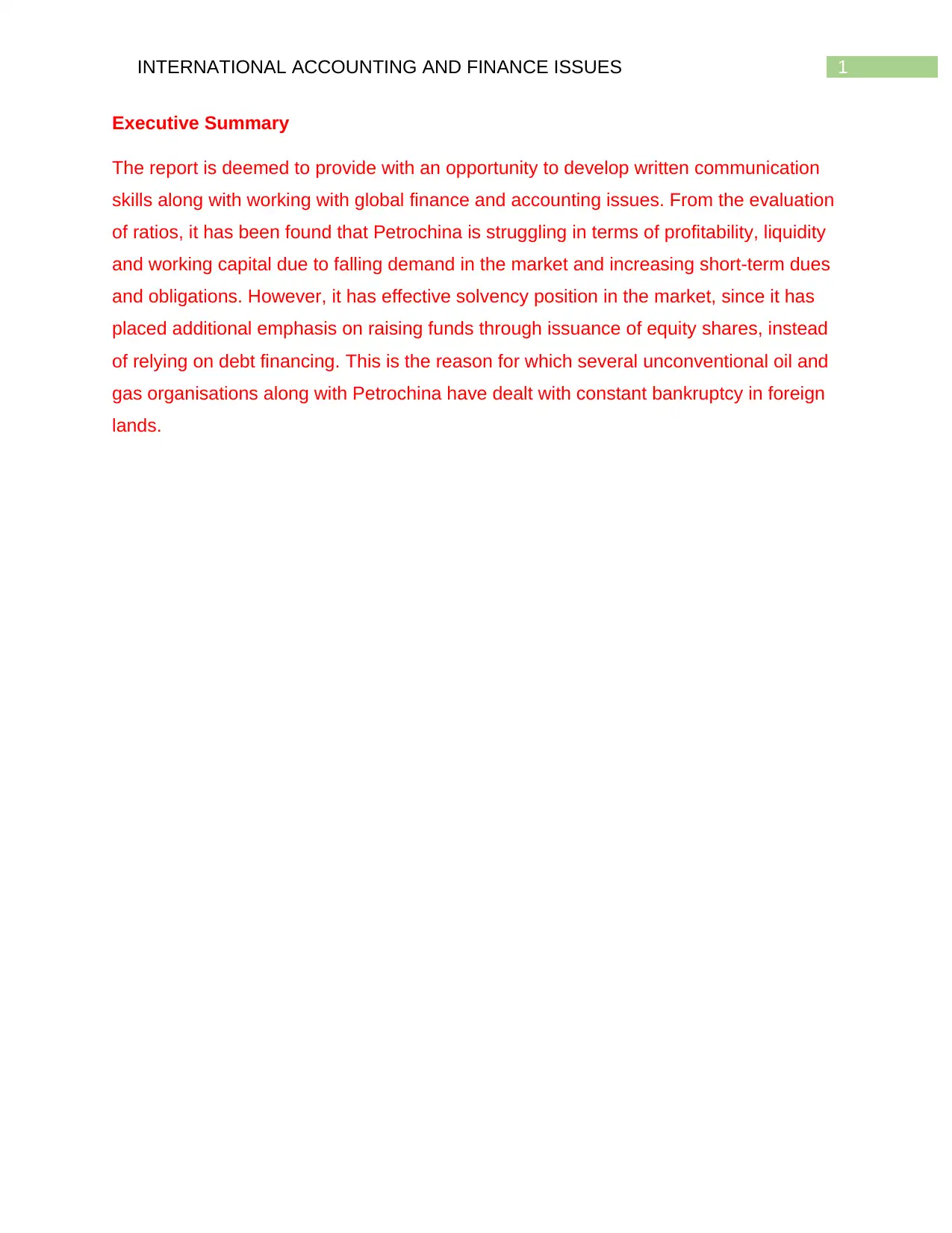
1INTERNATIONAL ACCOUNTING AND FINANCE ISSUES
Executive Summary
The report is deemed to provide with an opportunity to develop written communication
skills along with working with global finance and accounting issues. From the evaluation
of ratios, it has been found that Petrochina is struggling in terms of profitability, liquidity
and working capital due to falling demand in the market and increasing short-term dues
and obligations. However, it has effective solvency position in the market, since it has
placed additional emphasis on raising funds through issuance of equity shares, instead
of relying on debt financing. This is the reason for which several unconventional oil and
gas organisations along with Petrochina have dealt with constant bankruptcy in foreign
lands.
Executive Summary
The report is deemed to provide with an opportunity to develop written communication
skills along with working with global finance and accounting issues. From the evaluation
of ratios, it has been found that Petrochina is struggling in terms of profitability, liquidity
and working capital due to falling demand in the market and increasing short-term dues
and obligations. However, it has effective solvency position in the market, since it has
placed additional emphasis on raising funds through issuance of equity shares, instead
of relying on debt financing. This is the reason for which several unconventional oil and
gas organisations along with Petrochina have dealt with constant bankruptcy in foreign
lands.

2INTERNATIONAL ACCOUNTING AND FINANCE ISSUES
Table of Contents
Introduction:.......................................................................................................................3
Background:.......................................................................................................................3
Financial Statement Analysis:...........................................................................................3
Independent Audit and Assurance:...................................................................................8
Impact on Financial Crisis on Petrochina Globally:.........................................................10
Conclusion:......................................................................................................................12
References:......................................................................................................................14
Appendices:.....................................................................................................................17
Table of Contents
Introduction:.......................................................................................................................3
Background:.......................................................................................................................3
Financial Statement Analysis:...........................................................................................3
Independent Audit and Assurance:...................................................................................8
Impact on Financial Crisis on Petrochina Globally:.........................................................10
Conclusion:......................................................................................................................12
References:......................................................................................................................14
Appendices:.....................................................................................................................17
⊘ This is a preview!⊘
Do you want full access?
Subscribe today to unlock all pages.

Trusted by 1+ million students worldwide
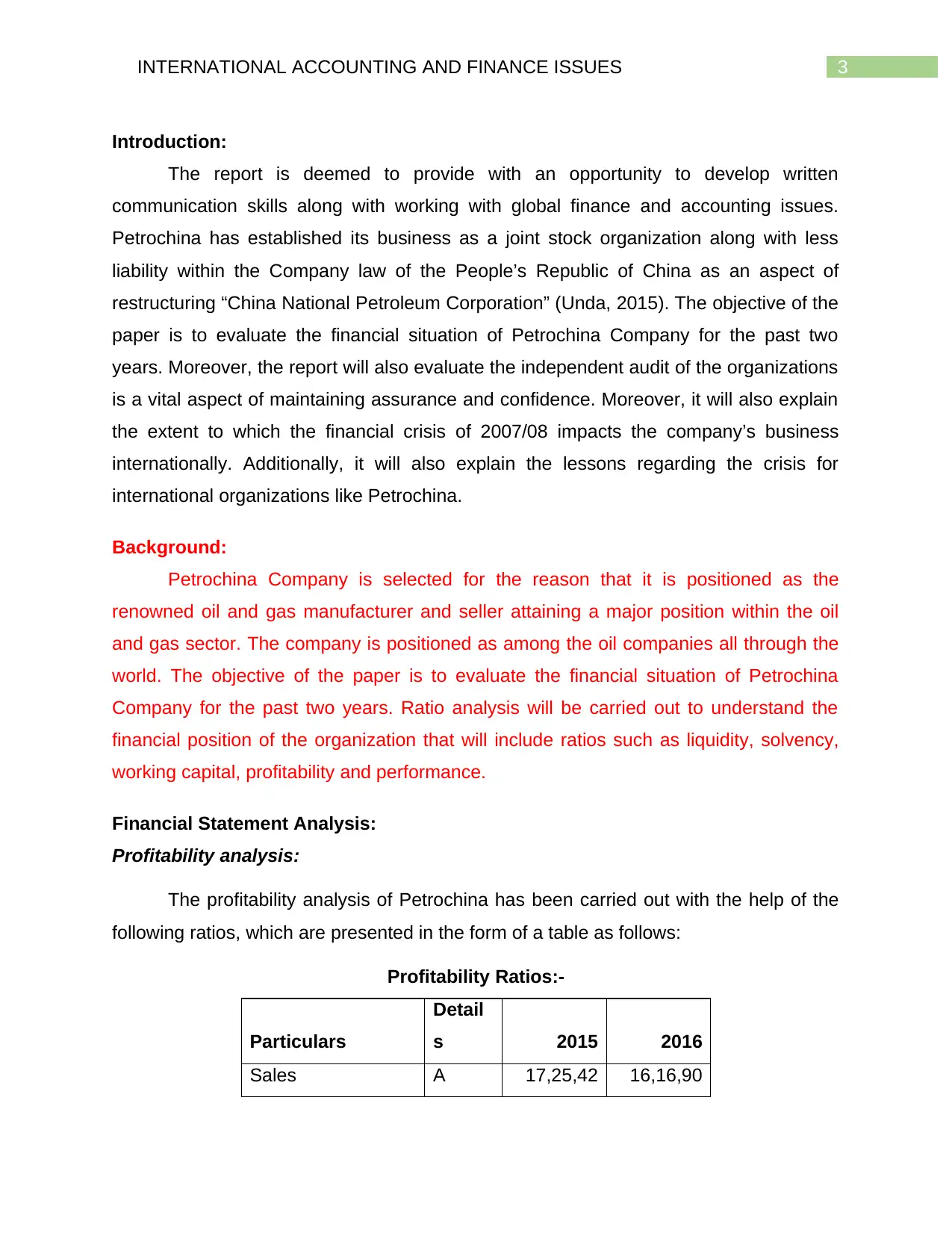
3INTERNATIONAL ACCOUNTING AND FINANCE ISSUES
Introduction:
The report is deemed to provide with an opportunity to develop written
communication skills along with working with global finance and accounting issues.
Petrochina has established its business as a joint stock organization along with less
liability within the Company law of the People’s Republic of China as an aspect of
restructuring “China National Petroleum Corporation” (Unda, 2015). The objective of the
paper is to evaluate the financial situation of Petrochina Company for the past two
years. Moreover, the report will also evaluate the independent audit of the organizations
is a vital aspect of maintaining assurance and confidence. Moreover, it will also explain
the extent to which the financial crisis of 2007/08 impacts the company’s business
internationally. Additionally, it will also explain the lessons regarding the crisis for
international organizations like Petrochina.
Background:
Petrochina Company is selected for the reason that it is positioned as the
renowned oil and gas manufacturer and seller attaining a major position within the oil
and gas sector. The company is positioned as among the oil companies all through the
world. The objective of the paper is to evaluate the financial situation of Petrochina
Company for the past two years. Ratio analysis will be carried out to understand the
financial position of the organization that will include ratios such as liquidity, solvency,
working capital, profitability and performance.
Financial Statement Analysis:
Profitability analysis:
The profitability analysis of Petrochina has been carried out with the help of the
following ratios, which are presented in the form of a table as follows:
Profitability Ratios:-
Particulars
Detail
s 2015 2016
Sales A 17,25,42 16,16,90
Introduction:
The report is deemed to provide with an opportunity to develop written
communication skills along with working with global finance and accounting issues.
Petrochina has established its business as a joint stock organization along with less
liability within the Company law of the People’s Republic of China as an aspect of
restructuring “China National Petroleum Corporation” (Unda, 2015). The objective of the
paper is to evaluate the financial situation of Petrochina Company for the past two
years. Moreover, the report will also evaluate the independent audit of the organizations
is a vital aspect of maintaining assurance and confidence. Moreover, it will also explain
the extent to which the financial crisis of 2007/08 impacts the company’s business
internationally. Additionally, it will also explain the lessons regarding the crisis for
international organizations like Petrochina.
Background:
Petrochina Company is selected for the reason that it is positioned as the
renowned oil and gas manufacturer and seller attaining a major position within the oil
and gas sector. The company is positioned as among the oil companies all through the
world. The objective of the paper is to evaluate the financial situation of Petrochina
Company for the past two years. Ratio analysis will be carried out to understand the
financial position of the organization that will include ratios such as liquidity, solvency,
working capital, profitability and performance.
Financial Statement Analysis:
Profitability analysis:
The profitability analysis of Petrochina has been carried out with the help of the
following ratios, which are presented in the form of a table as follows:
Profitability Ratios:-
Particulars
Detail
s 2015 2016
Sales A 17,25,42 16,16,90
Paraphrase This Document
Need a fresh take? Get an instant paraphrase of this document with our AI Paraphraser
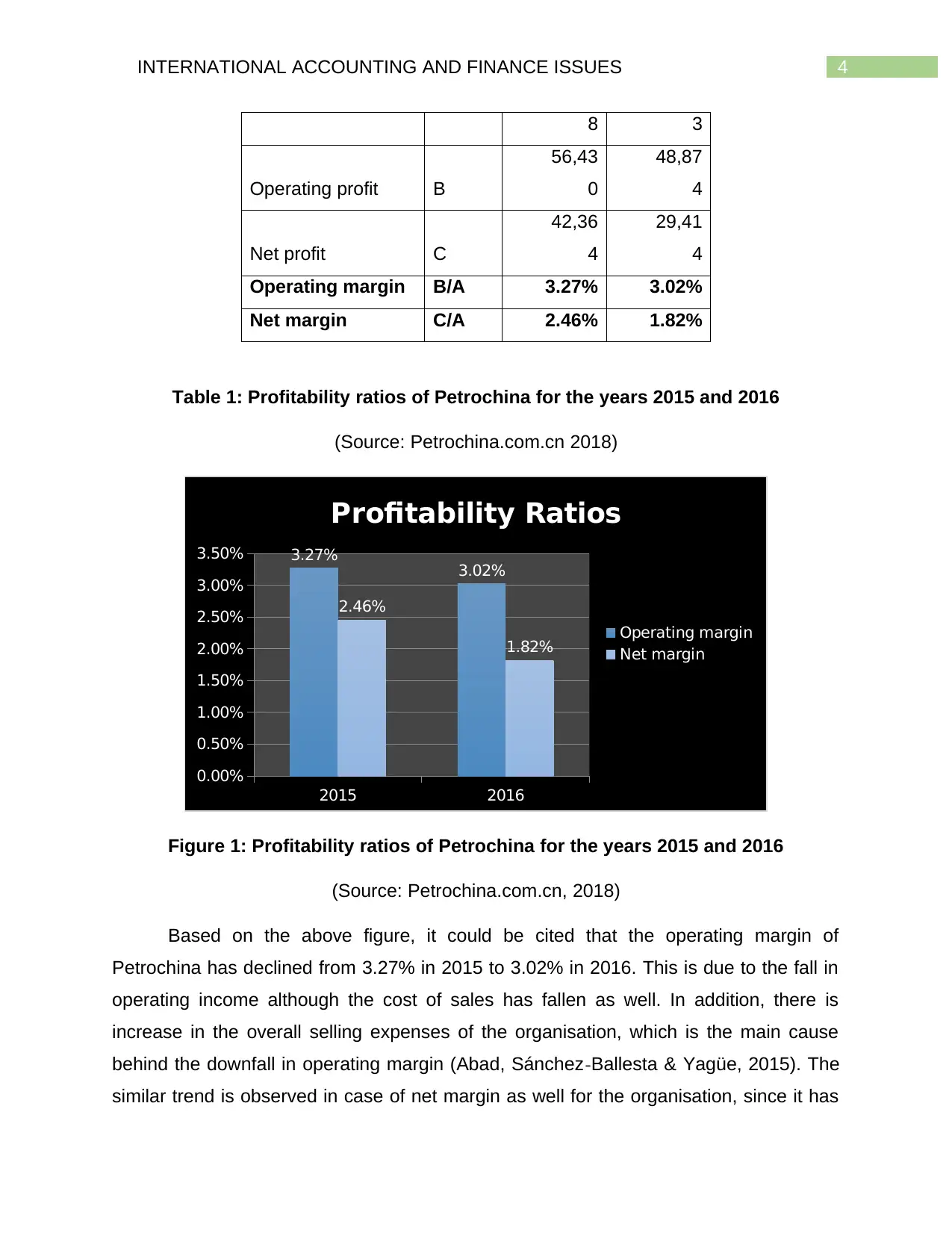
4INTERNATIONAL ACCOUNTING AND FINANCE ISSUES
8 3
Operating profit B
56,43
0
48,87
4
Net profit C
42,36
4
29,41
4
Operating margin B/A 3.27% 3.02%
Net margin C/A 2.46% 1.82%
Table 1: Profitability ratios of Petrochina for the years 2015 and 2016
(Source: Petrochina.com.cn 2018)
2015 2016
0.00%
0.50%
1.00%
1.50%
2.00%
2.50%
3.00%
3.50% 3.27%
3.02%
2.46%
1.82%
Profitability Ratios
Operating margin
Net margin
Figure 1: Profitability ratios of Petrochina for the years 2015 and 2016
(Source: Petrochina.com.cn, 2018)
Based on the above figure, it could be cited that the operating margin of
Petrochina has declined from 3.27% in 2015 to 3.02% in 2016. This is due to the fall in
operating income although the cost of sales has fallen as well. In addition, there is
increase in the overall selling expenses of the organisation, which is the main cause
behind the downfall in operating margin (Abad, Sánchez‐Ballesta & Yagüe, 2015). The
similar trend is observed in case of net margin as well for the organisation, since it has
8 3
Operating profit B
56,43
0
48,87
4
Net profit C
42,36
4
29,41
4
Operating margin B/A 3.27% 3.02%
Net margin C/A 2.46% 1.82%
Table 1: Profitability ratios of Petrochina for the years 2015 and 2016
(Source: Petrochina.com.cn 2018)
2015 2016
0.00%
0.50%
1.00%
1.50%
2.00%
2.50%
3.00%
3.50% 3.27%
3.02%
2.46%
1.82%
Profitability Ratios
Operating margin
Net margin
Figure 1: Profitability ratios of Petrochina for the years 2015 and 2016
(Source: Petrochina.com.cn, 2018)
Based on the above figure, it could be cited that the operating margin of
Petrochina has declined from 3.27% in 2015 to 3.02% in 2016. This is due to the fall in
operating income although the cost of sales has fallen as well. In addition, there is
increase in the overall selling expenses of the organisation, which is the main cause
behind the downfall in operating margin (Abad, Sánchez‐Ballesta & Yagüe, 2015). The
similar trend is observed in case of net margin as well for the organisation, since it has
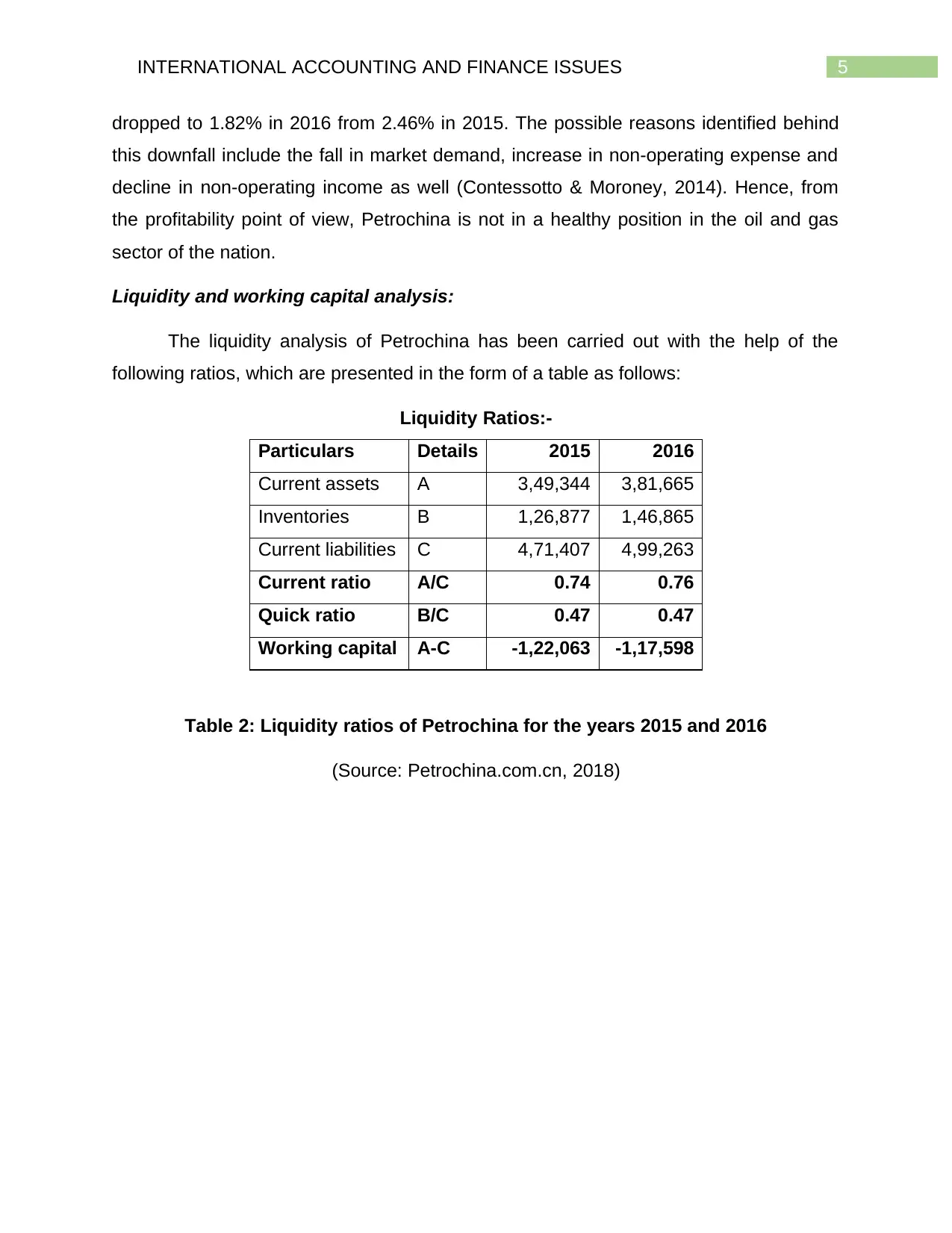
5INTERNATIONAL ACCOUNTING AND FINANCE ISSUES
dropped to 1.82% in 2016 from 2.46% in 2015. The possible reasons identified behind
this downfall include the fall in market demand, increase in non-operating expense and
decline in non-operating income as well (Contessotto & Moroney, 2014). Hence, from
the profitability point of view, Petrochina is not in a healthy position in the oil and gas
sector of the nation.
Liquidity and working capital analysis:
The liquidity analysis of Petrochina has been carried out with the help of the
following ratios, which are presented in the form of a table as follows:
Liquidity Ratios:-
Particulars Details 2015 2016
Current assets A 3,49,344 3,81,665
Inventories B 1,26,877 1,46,865
Current liabilities C 4,71,407 4,99,263
Current ratio A/C 0.74 0.76
Quick ratio B/C 0.47 0.47
Working capital A-C -1,22,063 -1,17,598
Table 2: Liquidity ratios of Petrochina for the years 2015 and 2016
(Source: Petrochina.com.cn, 2018)
dropped to 1.82% in 2016 from 2.46% in 2015. The possible reasons identified behind
this downfall include the fall in market demand, increase in non-operating expense and
decline in non-operating income as well (Contessotto & Moroney, 2014). Hence, from
the profitability point of view, Petrochina is not in a healthy position in the oil and gas
sector of the nation.
Liquidity and working capital analysis:
The liquidity analysis of Petrochina has been carried out with the help of the
following ratios, which are presented in the form of a table as follows:
Liquidity Ratios:-
Particulars Details 2015 2016
Current assets A 3,49,344 3,81,665
Inventories B 1,26,877 1,46,865
Current liabilities C 4,71,407 4,99,263
Current ratio A/C 0.74 0.76
Quick ratio B/C 0.47 0.47
Working capital A-C -1,22,063 -1,17,598
Table 2: Liquidity ratios of Petrochina for the years 2015 and 2016
(Source: Petrochina.com.cn, 2018)
⊘ This is a preview!⊘
Do you want full access?
Subscribe today to unlock all pages.

Trusted by 1+ million students worldwide
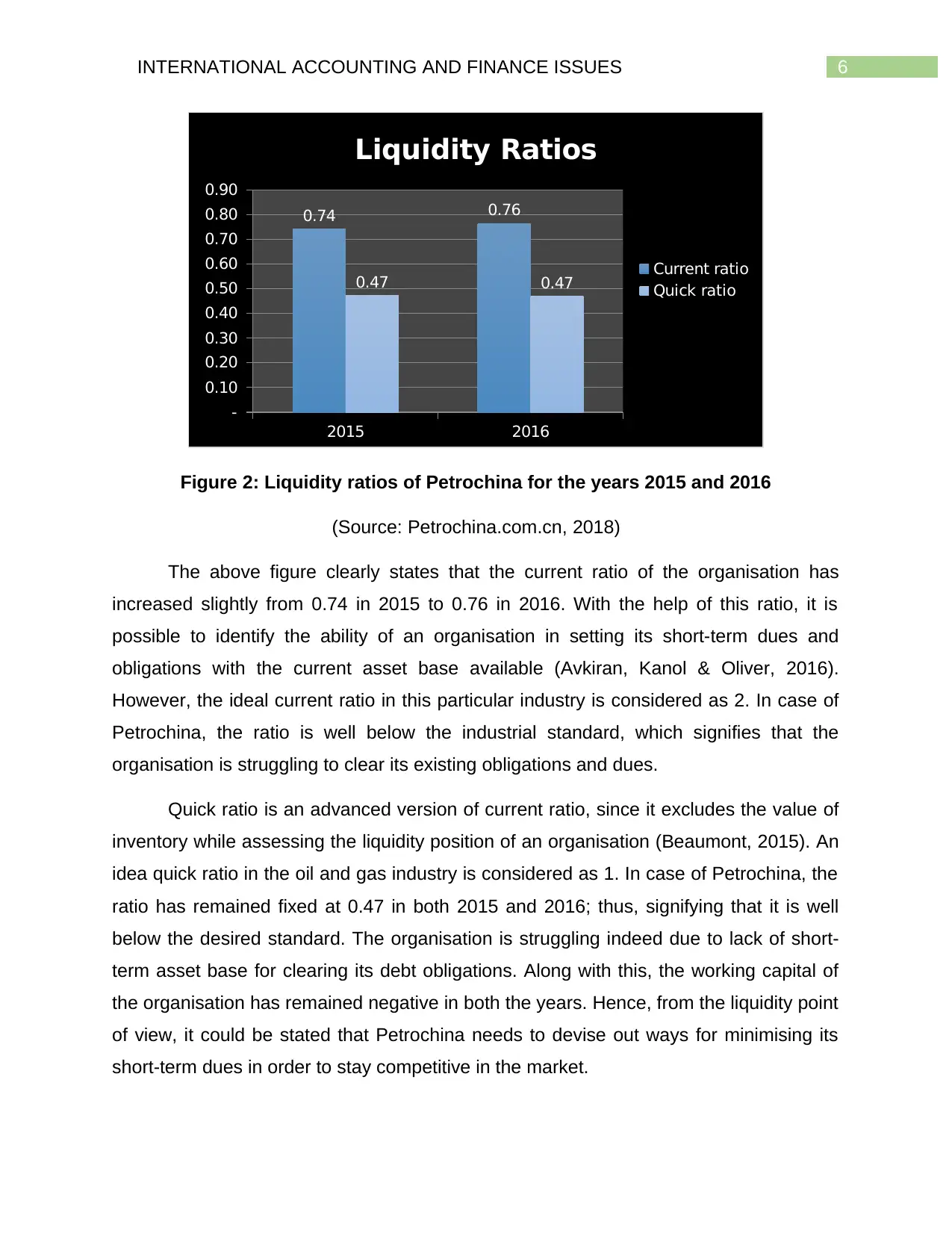
6INTERNATIONAL ACCOUNTING AND FINANCE ISSUES
2015 2016
-
0.10
0.20
0.30
0.40
0.50
0.60
0.70
0.80
0.90
0.74 0.76
0.47 0.47
Liquidity Ratios
Current ratio
Quick ratio
Figure 2: Liquidity ratios of Petrochina for the years 2015 and 2016
(Source: Petrochina.com.cn, 2018)
The above figure clearly states that the current ratio of the organisation has
increased slightly from 0.74 in 2015 to 0.76 in 2016. With the help of this ratio, it is
possible to identify the ability of an organisation in setting its short-term dues and
obligations with the current asset base available (Avkiran, Kanol & Oliver, 2016).
However, the ideal current ratio in this particular industry is considered as 2. In case of
Petrochina, the ratio is well below the industrial standard, which signifies that the
organisation is struggling to clear its existing obligations and dues.
Quick ratio is an advanced version of current ratio, since it excludes the value of
inventory while assessing the liquidity position of an organisation (Beaumont, 2015). An
idea quick ratio in the oil and gas industry is considered as 1. In case of Petrochina, the
ratio has remained fixed at 0.47 in both 2015 and 2016; thus, signifying that it is well
below the desired standard. The organisation is struggling indeed due to lack of short-
term asset base for clearing its debt obligations. Along with this, the working capital of
the organisation has remained negative in both the years. Hence, from the liquidity point
of view, it could be stated that Petrochina needs to devise out ways for minimising its
short-term dues in order to stay competitive in the market.
2015 2016
-
0.10
0.20
0.30
0.40
0.50
0.60
0.70
0.80
0.90
0.74 0.76
0.47 0.47
Liquidity Ratios
Current ratio
Quick ratio
Figure 2: Liquidity ratios of Petrochina for the years 2015 and 2016
(Source: Petrochina.com.cn, 2018)
The above figure clearly states that the current ratio of the organisation has
increased slightly from 0.74 in 2015 to 0.76 in 2016. With the help of this ratio, it is
possible to identify the ability of an organisation in setting its short-term dues and
obligations with the current asset base available (Avkiran, Kanol & Oliver, 2016).
However, the ideal current ratio in this particular industry is considered as 2. In case of
Petrochina, the ratio is well below the industrial standard, which signifies that the
organisation is struggling to clear its existing obligations and dues.
Quick ratio is an advanced version of current ratio, since it excludes the value of
inventory while assessing the liquidity position of an organisation (Beaumont, 2015). An
idea quick ratio in the oil and gas industry is considered as 1. In case of Petrochina, the
ratio has remained fixed at 0.47 in both 2015 and 2016; thus, signifying that it is well
below the desired standard. The organisation is struggling indeed due to lack of short-
term asset base for clearing its debt obligations. Along with this, the working capital of
the organisation has remained negative in both the years. Hence, from the liquidity point
of view, it could be stated that Petrochina needs to devise out ways for minimising its
short-term dues in order to stay competitive in the market.
Paraphrase This Document
Need a fresh take? Get an instant paraphrase of this document with our AI Paraphraser
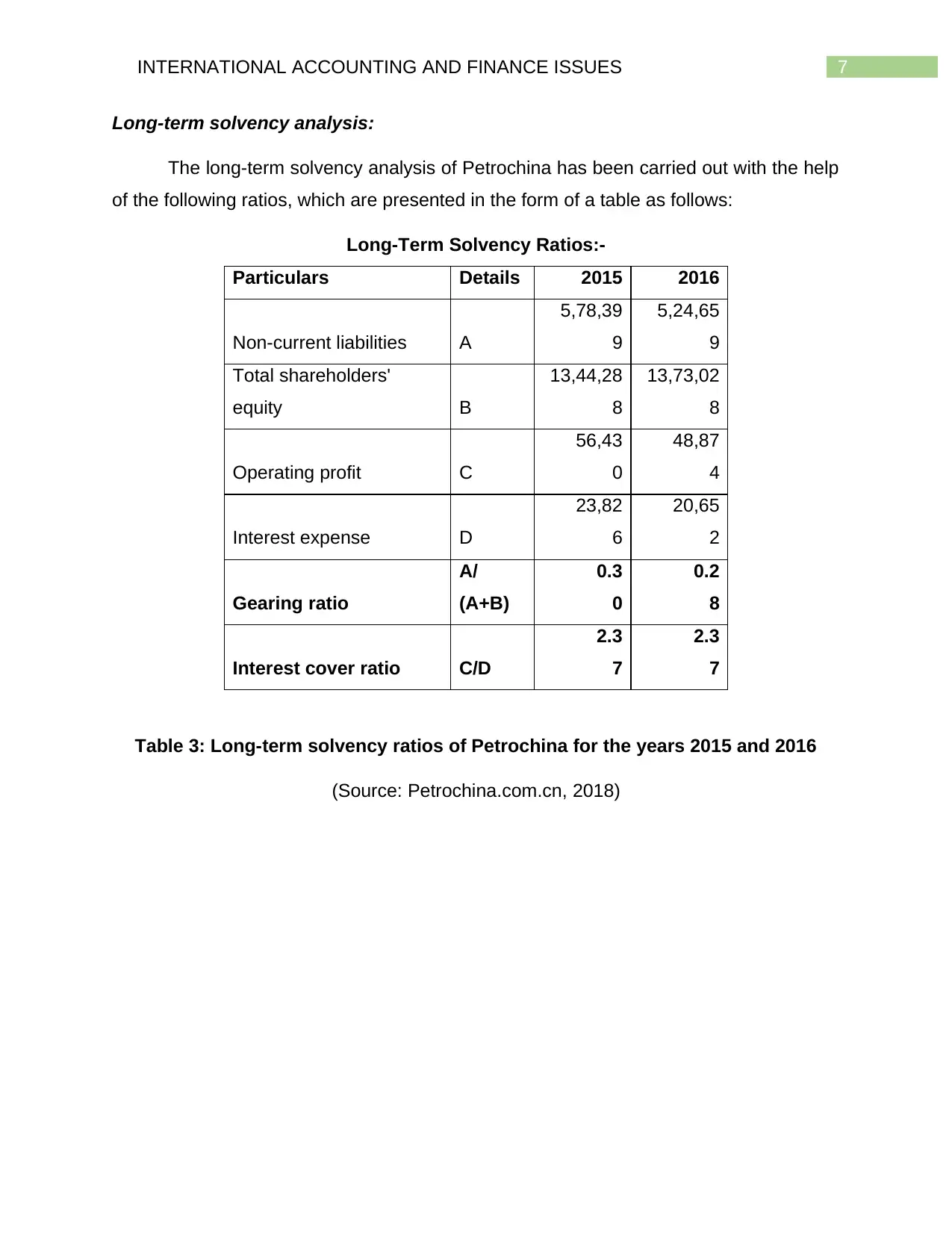
7INTERNATIONAL ACCOUNTING AND FINANCE ISSUES
Long-term solvency analysis:
The long-term solvency analysis of Petrochina has been carried out with the help
of the following ratios, which are presented in the form of a table as follows:
Long-Term Solvency Ratios:-
Particulars Details 2015 2016
Non-current liabilities A
5,78,39
9
5,24,65
9
Total shareholders'
equity B
13,44,28
8
13,73,02
8
Operating profit C
56,43
0
48,87
4
Interest expense D
23,82
6
20,65
2
Gearing ratio
A/
(A+B)
0.3
0
0.2
8
Interest cover ratio C/D
2.3
7
2.3
7
Table 3: Long-term solvency ratios of Petrochina for the years 2015 and 2016
(Source: Petrochina.com.cn, 2018)
Long-term solvency analysis:
The long-term solvency analysis of Petrochina has been carried out with the help
of the following ratios, which are presented in the form of a table as follows:
Long-Term Solvency Ratios:-
Particulars Details 2015 2016
Non-current liabilities A
5,78,39
9
5,24,65
9
Total shareholders'
equity B
13,44,28
8
13,73,02
8
Operating profit C
56,43
0
48,87
4
Interest expense D
23,82
6
20,65
2
Gearing ratio
A/
(A+B)
0.3
0
0.2
8
Interest cover ratio C/D
2.3
7
2.3
7
Table 3: Long-term solvency ratios of Petrochina for the years 2015 and 2016
(Source: Petrochina.com.cn, 2018)
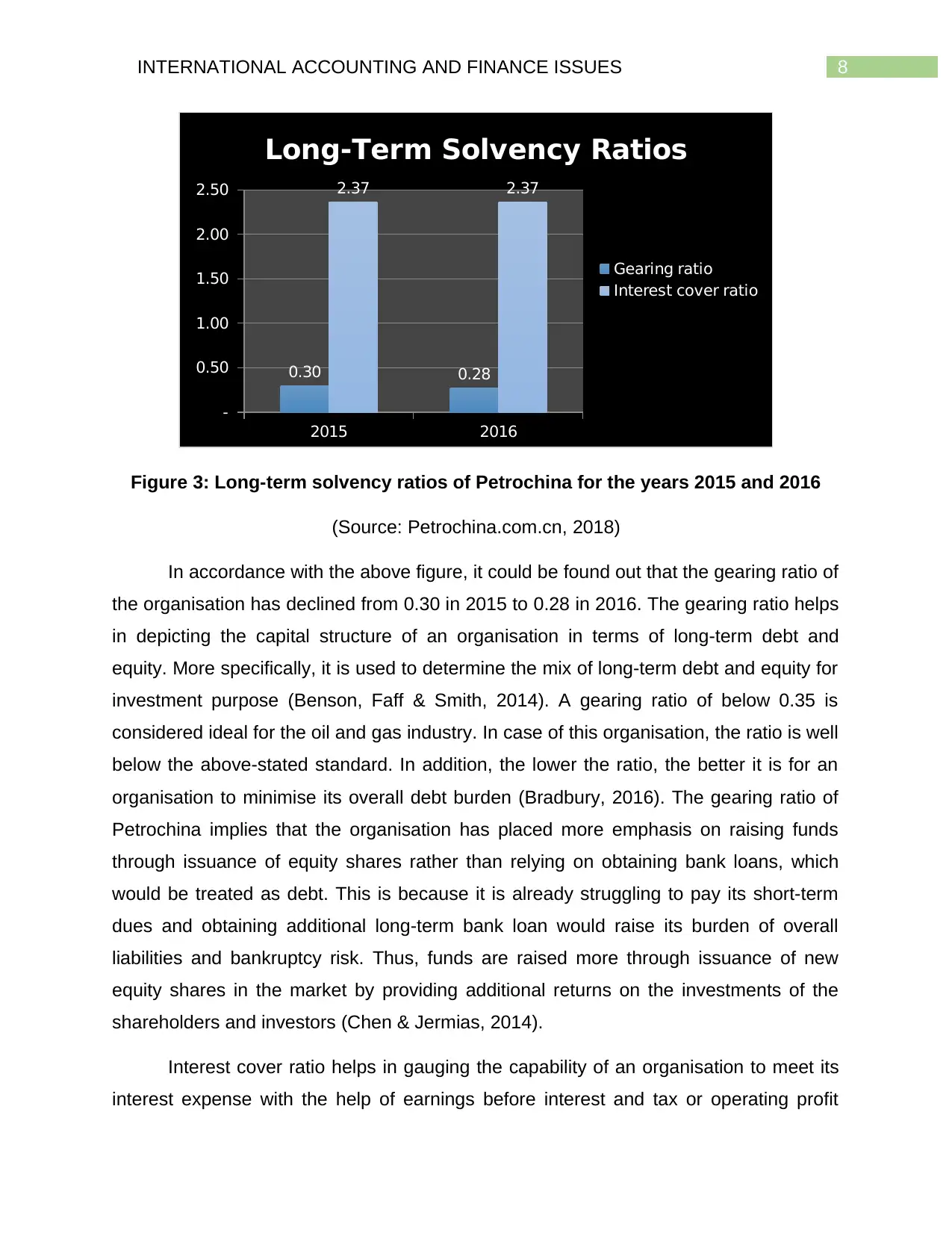
8INTERNATIONAL ACCOUNTING AND FINANCE ISSUES
2015 2016
-
0.50
1.00
1.50
2.00
2.50
0.30 0.28
2.37 2.37
Long-Term Solvency Ratios
Gearing ratio
Interest cover ratio
Figure 3: Long-term solvency ratios of Petrochina for the years 2015 and 2016
(Source: Petrochina.com.cn, 2018)
In accordance with the above figure, it could be found out that the gearing ratio of
the organisation has declined from 0.30 in 2015 to 0.28 in 2016. The gearing ratio helps
in depicting the capital structure of an organisation in terms of long-term debt and
equity. More specifically, it is used to determine the mix of long-term debt and equity for
investment purpose (Benson, Faff & Smith, 2014). A gearing ratio of below 0.35 is
considered ideal for the oil and gas industry. In case of this organisation, the ratio is well
below the above-stated standard. In addition, the lower the ratio, the better it is for an
organisation to minimise its overall debt burden (Bradbury, 2016). The gearing ratio of
Petrochina implies that the organisation has placed more emphasis on raising funds
through issuance of equity shares rather than relying on obtaining bank loans, which
would be treated as debt. This is because it is already struggling to pay its short-term
dues and obtaining additional long-term bank loan would raise its burden of overall
liabilities and bankruptcy risk. Thus, funds are raised more through issuance of new
equity shares in the market by providing additional returns on the investments of the
shareholders and investors (Chen & Jermias, 2014).
Interest cover ratio helps in gauging the capability of an organisation to meet its
interest expense with the help of earnings before interest and tax or operating profit
2015 2016
-
0.50
1.00
1.50
2.00
2.50
0.30 0.28
2.37 2.37
Long-Term Solvency Ratios
Gearing ratio
Interest cover ratio
Figure 3: Long-term solvency ratios of Petrochina for the years 2015 and 2016
(Source: Petrochina.com.cn, 2018)
In accordance with the above figure, it could be found out that the gearing ratio of
the organisation has declined from 0.30 in 2015 to 0.28 in 2016. The gearing ratio helps
in depicting the capital structure of an organisation in terms of long-term debt and
equity. More specifically, it is used to determine the mix of long-term debt and equity for
investment purpose (Benson, Faff & Smith, 2014). A gearing ratio of below 0.35 is
considered ideal for the oil and gas industry. In case of this organisation, the ratio is well
below the above-stated standard. In addition, the lower the ratio, the better it is for an
organisation to minimise its overall debt burden (Bradbury, 2016). The gearing ratio of
Petrochina implies that the organisation has placed more emphasis on raising funds
through issuance of equity shares rather than relying on obtaining bank loans, which
would be treated as debt. This is because it is already struggling to pay its short-term
dues and obtaining additional long-term bank loan would raise its burden of overall
liabilities and bankruptcy risk. Thus, funds are raised more through issuance of new
equity shares in the market by providing additional returns on the investments of the
shareholders and investors (Chen & Jermias, 2014).
Interest cover ratio helps in gauging the capability of an organisation to meet its
interest expense with the help of earnings before interest and tax or operating profit
⊘ This is a preview!⊘
Do you want full access?
Subscribe today to unlock all pages.

Trusted by 1+ million students worldwide
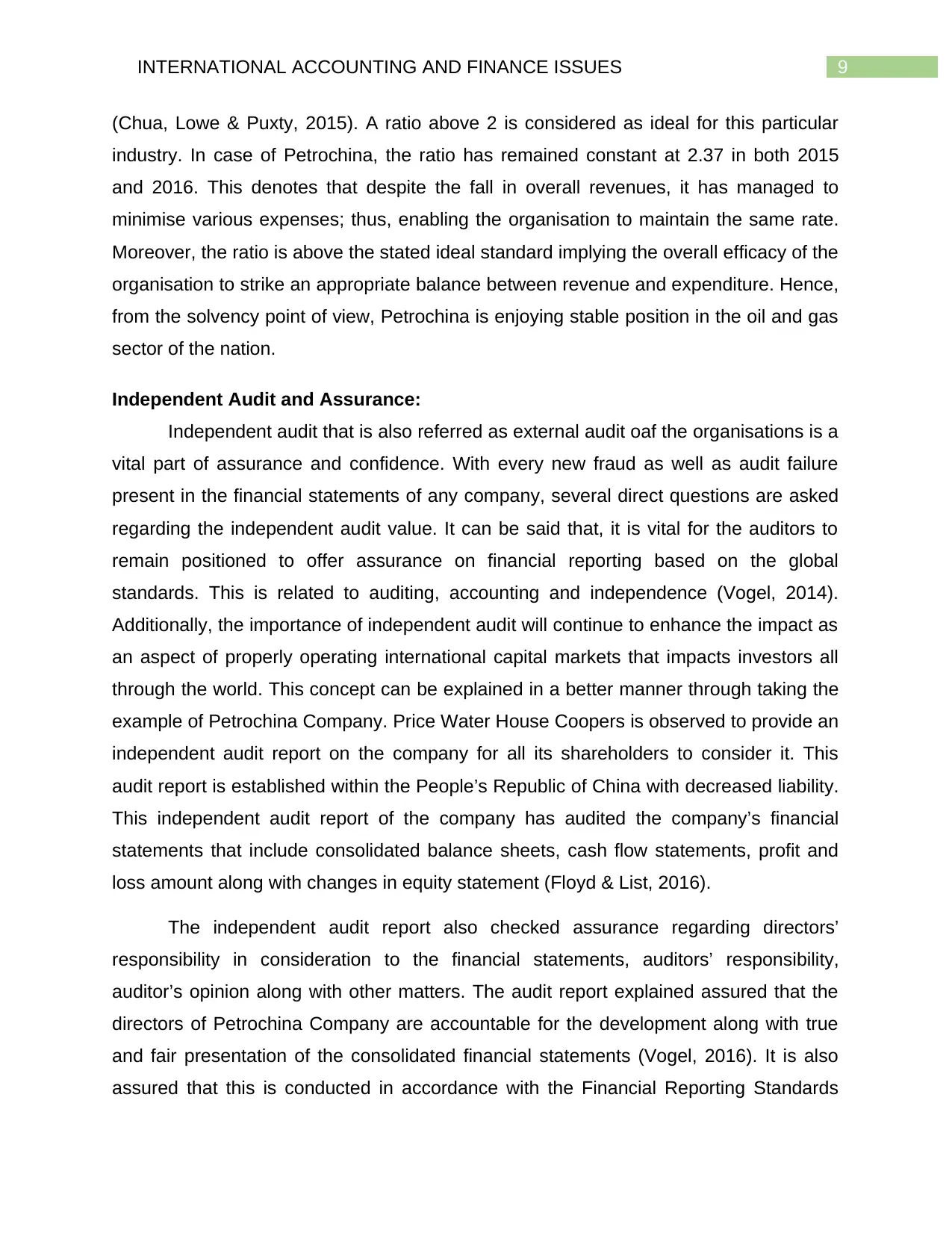
9INTERNATIONAL ACCOUNTING AND FINANCE ISSUES
(Chua, Lowe & Puxty, 2015). A ratio above 2 is considered as ideal for this particular
industry. In case of Petrochina, the ratio has remained constant at 2.37 in both 2015
and 2016. This denotes that despite the fall in overall revenues, it has managed to
minimise various expenses; thus, enabling the organisation to maintain the same rate.
Moreover, the ratio is above the stated ideal standard implying the overall efficacy of the
organisation to strike an appropriate balance between revenue and expenditure. Hence,
from the solvency point of view, Petrochina is enjoying stable position in the oil and gas
sector of the nation.
Independent Audit and Assurance:
Independent audit that is also referred as external audit oaf the organisations is a
vital part of assurance and confidence. With every new fraud as well as audit failure
present in the financial statements of any company, several direct questions are asked
regarding the independent audit value. It can be said that, it is vital for the auditors to
remain positioned to offer assurance on financial reporting based on the global
standards. This is related to auditing, accounting and independence (Vogel, 2014).
Additionally, the importance of independent audit will continue to enhance the impact as
an aspect of properly operating international capital markets that impacts investors all
through the world. This concept can be explained in a better manner through taking the
example of Petrochina Company. Price Water House Coopers is observed to provide an
independent audit report on the company for all its shareholders to consider it. This
audit report is established within the People’s Republic of China with decreased liability.
This independent audit report of the company has audited the company’s financial
statements that include consolidated balance sheets, cash flow statements, profit and
loss amount along with changes in equity statement (Floyd & List, 2016).
The independent audit report also checked assurance regarding directors’
responsibility in consideration to the financial statements, auditors’ responsibility,
auditor’s opinion along with other matters. The audit report explained assured that the
directors of Petrochina Company are accountable for the development along with true
and fair presentation of the consolidated financial statements (Vogel, 2016). It is also
assured that this is conducted in accordance with the Financial Reporting Standards
(Chua, Lowe & Puxty, 2015). A ratio above 2 is considered as ideal for this particular
industry. In case of Petrochina, the ratio has remained constant at 2.37 in both 2015
and 2016. This denotes that despite the fall in overall revenues, it has managed to
minimise various expenses; thus, enabling the organisation to maintain the same rate.
Moreover, the ratio is above the stated ideal standard implying the overall efficacy of the
organisation to strike an appropriate balance between revenue and expenditure. Hence,
from the solvency point of view, Petrochina is enjoying stable position in the oil and gas
sector of the nation.
Independent Audit and Assurance:
Independent audit that is also referred as external audit oaf the organisations is a
vital part of assurance and confidence. With every new fraud as well as audit failure
present in the financial statements of any company, several direct questions are asked
regarding the independent audit value. It can be said that, it is vital for the auditors to
remain positioned to offer assurance on financial reporting based on the global
standards. This is related to auditing, accounting and independence (Vogel, 2014).
Additionally, the importance of independent audit will continue to enhance the impact as
an aspect of properly operating international capital markets that impacts investors all
through the world. This concept can be explained in a better manner through taking the
example of Petrochina Company. Price Water House Coopers is observed to provide an
independent audit report on the company for all its shareholders to consider it. This
audit report is established within the People’s Republic of China with decreased liability.
This independent audit report of the company has audited the company’s financial
statements that include consolidated balance sheets, cash flow statements, profit and
loss amount along with changes in equity statement (Floyd & List, 2016).
The independent audit report also checked assurance regarding directors’
responsibility in consideration to the financial statements, auditors’ responsibility,
auditor’s opinion along with other matters. The audit report explained assured that the
directors of Petrochina Company are accountable for the development along with true
and fair presentation of the consolidated financial statements (Vogel, 2016). It is also
assured that this is conducted in accordance with the Financial Reporting Standards
Paraphrase This Document
Need a fresh take? Get an instant paraphrase of this document with our AI Paraphraser
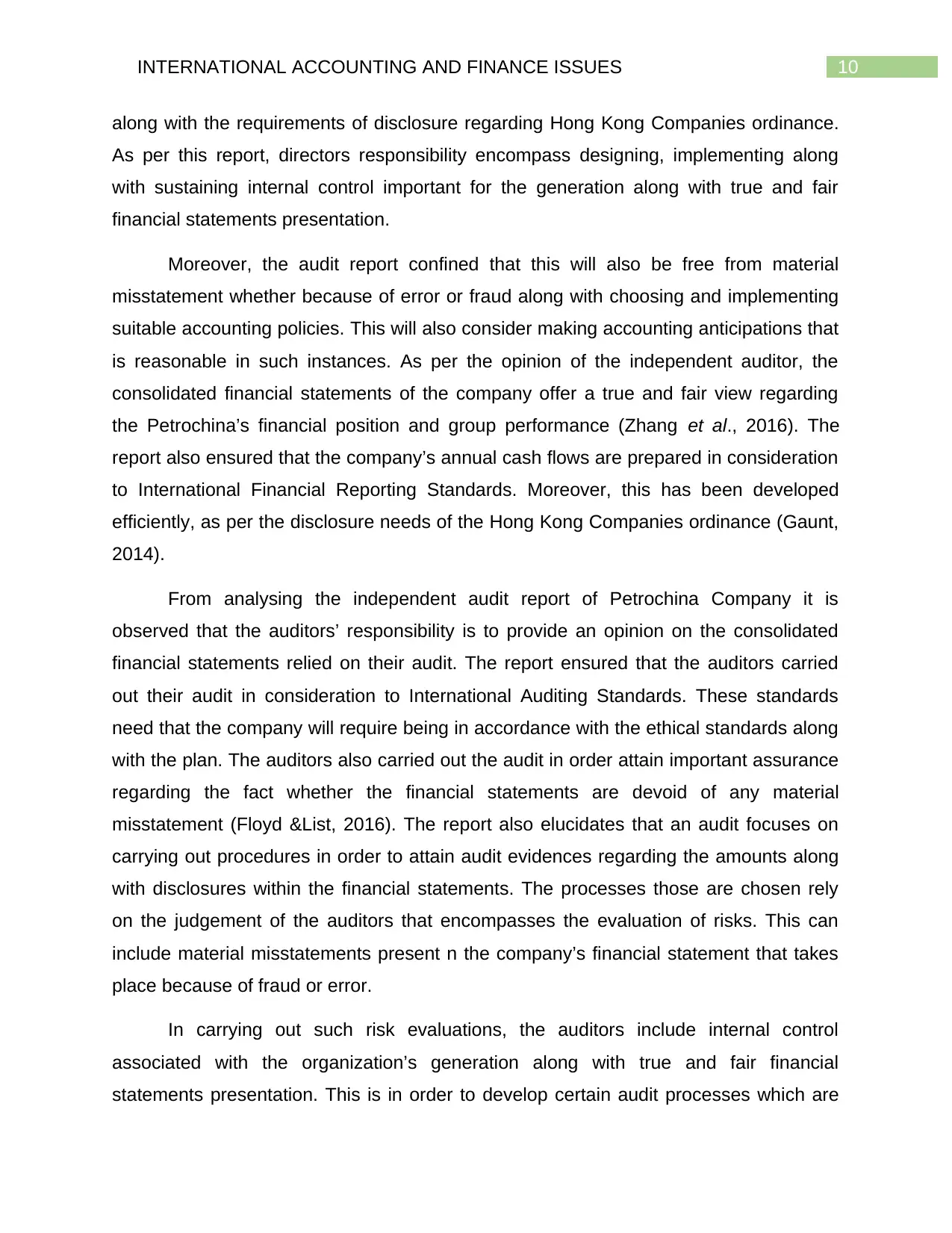
10INTERNATIONAL ACCOUNTING AND FINANCE ISSUES
along with the requirements of disclosure regarding Hong Kong Companies ordinance.
As per this report, directors responsibility encompass designing, implementing along
with sustaining internal control important for the generation along with true and fair
financial statements presentation.
Moreover, the audit report confined that this will also be free from material
misstatement whether because of error or fraud along with choosing and implementing
suitable accounting policies. This will also consider making accounting anticipations that
is reasonable in such instances. As per the opinion of the independent auditor, the
consolidated financial statements of the company offer a true and fair view regarding
the Petrochina’s financial position and group performance (Zhang et al., 2016). The
report also ensured that the company’s annual cash flows are prepared in consideration
to International Financial Reporting Standards. Moreover, this has been developed
efficiently, as per the disclosure needs of the Hong Kong Companies ordinance (Gaunt,
2014).
From analysing the independent audit report of Petrochina Company it is
observed that the auditors’ responsibility is to provide an opinion on the consolidated
financial statements relied on their audit. The report ensured that the auditors carried
out their audit in consideration to International Auditing Standards. These standards
need that the company will require being in accordance with the ethical standards along
with the plan. The auditors also carried out the audit in order attain important assurance
regarding the fact whether the financial statements are devoid of any material
misstatement (Floyd &List, 2016). The report also elucidates that an audit focuses on
carrying out procedures in order to attain audit evidences regarding the amounts along
with disclosures within the financial statements. The processes those are chosen rely
on the judgement of the auditors that encompasses the evaluation of risks. This can
include material misstatements present n the company’s financial statement that takes
place because of fraud or error.
In carrying out such risk evaluations, the auditors include internal control
associated with the organization’s generation along with true and fair financial
statements presentation. This is in order to develop certain audit processes which are
along with the requirements of disclosure regarding Hong Kong Companies ordinance.
As per this report, directors responsibility encompass designing, implementing along
with sustaining internal control important for the generation along with true and fair
financial statements presentation.
Moreover, the audit report confined that this will also be free from material
misstatement whether because of error or fraud along with choosing and implementing
suitable accounting policies. This will also consider making accounting anticipations that
is reasonable in such instances. As per the opinion of the independent auditor, the
consolidated financial statements of the company offer a true and fair view regarding
the Petrochina’s financial position and group performance (Zhang et al., 2016). The
report also ensured that the company’s annual cash flows are prepared in consideration
to International Financial Reporting Standards. Moreover, this has been developed
efficiently, as per the disclosure needs of the Hong Kong Companies ordinance (Gaunt,
2014).
From analysing the independent audit report of Petrochina Company it is
observed that the auditors’ responsibility is to provide an opinion on the consolidated
financial statements relied on their audit. The report ensured that the auditors carried
out their audit in consideration to International Auditing Standards. These standards
need that the company will require being in accordance with the ethical standards along
with the plan. The auditors also carried out the audit in order attain important assurance
regarding the fact whether the financial statements are devoid of any material
misstatement (Floyd &List, 2016). The report also elucidates that an audit focuses on
carrying out procedures in order to attain audit evidences regarding the amounts along
with disclosures within the financial statements. The processes those are chosen rely
on the judgement of the auditors that encompasses the evaluation of risks. This can
include material misstatements present n the company’s financial statement that takes
place because of fraud or error.
In carrying out such risk evaluations, the auditors include internal control
associated with the organization’s generation along with true and fair financial
statements presentation. This is in order to develop certain audit processes which are
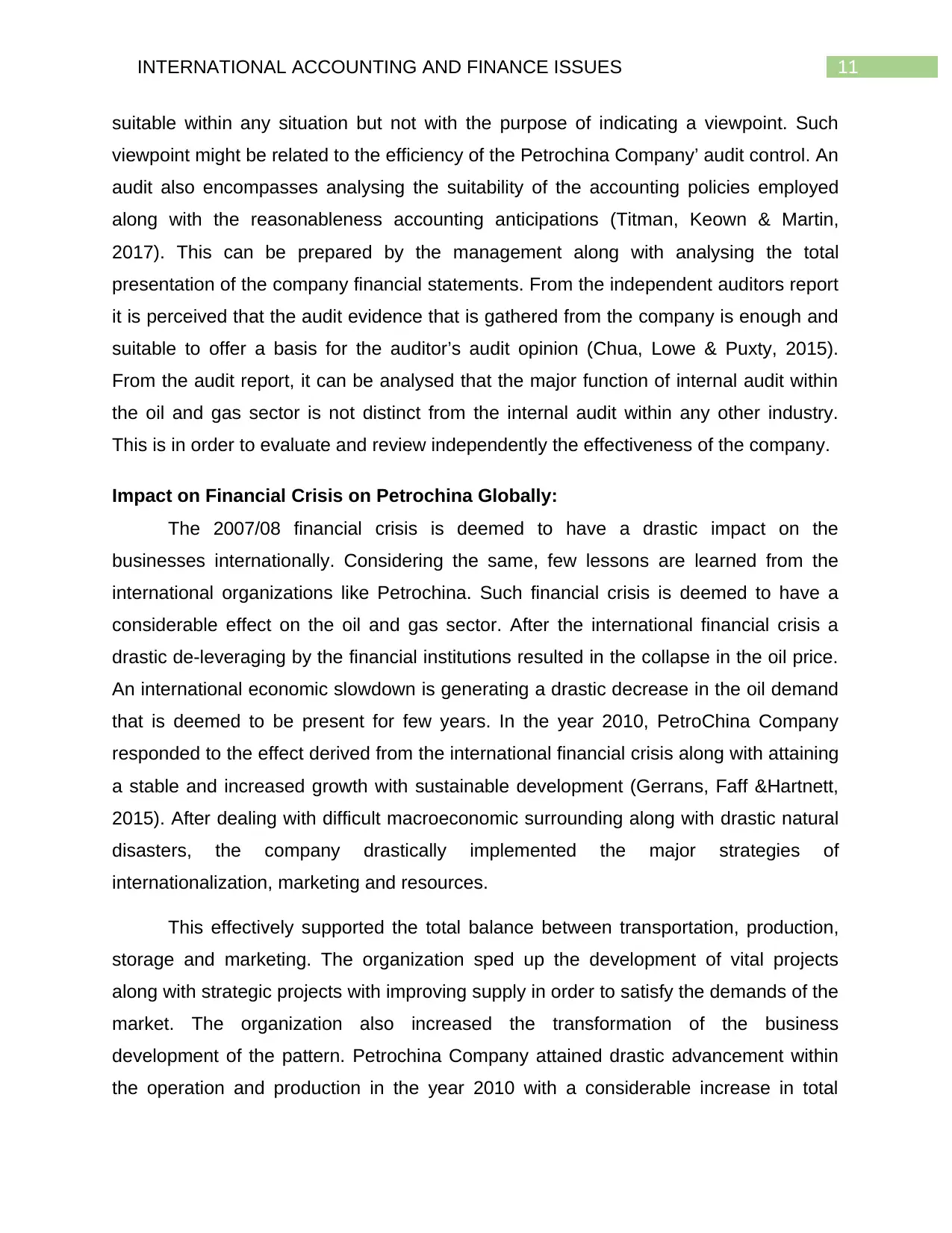
11INTERNATIONAL ACCOUNTING AND FINANCE ISSUES
suitable within any situation but not with the purpose of indicating a viewpoint. Such
viewpoint might be related to the efficiency of the Petrochina Company’ audit control. An
audit also encompasses analysing the suitability of the accounting policies employed
along with the reasonableness accounting anticipations (Titman, Keown & Martin,
2017). This can be prepared by the management along with analysing the total
presentation of the company financial statements. From the independent auditors report
it is perceived that the audit evidence that is gathered from the company is enough and
suitable to offer a basis for the auditor’s audit opinion (Chua, Lowe & Puxty, 2015).
From the audit report, it can be analysed that the major function of internal audit within
the oil and gas sector is not distinct from the internal audit within any other industry.
This is in order to evaluate and review independently the effectiveness of the company.
Impact on Financial Crisis on Petrochina Globally:
The 2007/08 financial crisis is deemed to have a drastic impact on the
businesses internationally. Considering the same, few lessons are learned from the
international organizations like Petrochina. Such financial crisis is deemed to have a
considerable effect on the oil and gas sector. After the international financial crisis a
drastic de-leveraging by the financial institutions resulted in the collapse in the oil price.
An international economic slowdown is generating a drastic decrease in the oil demand
that is deemed to be present for few years. In the year 2010, PetroChina Company
responded to the effect derived from the international financial crisis along with attaining
a stable and increased growth with sustainable development (Gerrans, Faff &Hartnett,
2015). After dealing with difficult macroeconomic surrounding along with drastic natural
disasters, the company drastically implemented the major strategies of
internationalization, marketing and resources.
This effectively supported the total balance between transportation, production,
storage and marketing. The organization sped up the development of vital projects
along with strategic projects with improving supply in order to satisfy the demands of the
market. The organization also increased the transformation of the business
development of the pattern. Petrochina Company attained drastic advancement within
the operation and production in the year 2010 with a considerable increase in total
suitable within any situation but not with the purpose of indicating a viewpoint. Such
viewpoint might be related to the efficiency of the Petrochina Company’ audit control. An
audit also encompasses analysing the suitability of the accounting policies employed
along with the reasonableness accounting anticipations (Titman, Keown & Martin,
2017). This can be prepared by the management along with analysing the total
presentation of the company financial statements. From the independent auditors report
it is perceived that the audit evidence that is gathered from the company is enough and
suitable to offer a basis for the auditor’s audit opinion (Chua, Lowe & Puxty, 2015).
From the audit report, it can be analysed that the major function of internal audit within
the oil and gas sector is not distinct from the internal audit within any other industry.
This is in order to evaluate and review independently the effectiveness of the company.
Impact on Financial Crisis on Petrochina Globally:
The 2007/08 financial crisis is deemed to have a drastic impact on the
businesses internationally. Considering the same, few lessons are learned from the
international organizations like Petrochina. Such financial crisis is deemed to have a
considerable effect on the oil and gas sector. After the international financial crisis a
drastic de-leveraging by the financial institutions resulted in the collapse in the oil price.
An international economic slowdown is generating a drastic decrease in the oil demand
that is deemed to be present for few years. In the year 2010, PetroChina Company
responded to the effect derived from the international financial crisis along with attaining
a stable and increased growth with sustainable development (Gerrans, Faff &Hartnett,
2015). After dealing with difficult macroeconomic surrounding along with drastic natural
disasters, the company drastically implemented the major strategies of
internationalization, marketing and resources.
This effectively supported the total balance between transportation, production,
storage and marketing. The organization sped up the development of vital projects
along with strategic projects with improving supply in order to satisfy the demands of the
market. The organization also increased the transformation of the business
development of the pattern. Petrochina Company attained drastic advancement within
the operation and production in the year 2010 with a considerable increase in total
⊘ This is a preview!⊘
Do you want full access?
Subscribe today to unlock all pages.

Trusted by 1+ million students worldwide
1 out of 19
Related Documents
Your All-in-One AI-Powered Toolkit for Academic Success.
+13062052269
info@desklib.com
Available 24*7 on WhatsApp / Email
![[object Object]](/_next/static/media/star-bottom.7253800d.svg)
Unlock your academic potential
Copyright © 2020–2025 A2Z Services. All Rights Reserved. Developed and managed by ZUCOL.





